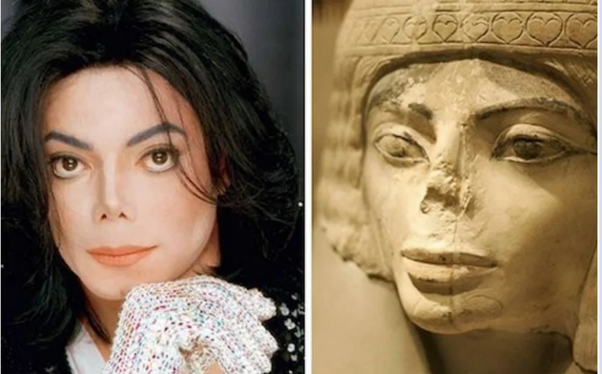The Field Museum in Chicago, one of the most renowned natural history museums in the United States, is home to an incredible collection of artifacts from ancient civilizations. However, one particular artifact has caught the attention of visitors for an unexpected reason—a 3,000-year-old Egyptian statue that bears an uncanny resemblance to the late pop icon, Michael Jackson.
The limestone bust, believed to date back to the New Kingdom period of Egypt (roughly 1550–1070 BC), was originally created to represent an unknown nobleman or deity. The artifact is notable for its distinct facial features: a narrow nose, high cheekbones, wide eyes, and a unique mouth shape—features that closely resemble those of the legendary King of Pop.
What makes this resemblance even more intriguing is that the statue was crafted thousands of years before Michael Jackson was even born. This strange similarity has sparked curiosity, amusement, and even conspiracy theories among fans and history enthusiasts alike.
Viral Fame and Fan Reactions
Ever since visitors first noticed the striking resemblance, the statue has become a viral sensation. Photos of the bust have circulated widely on social media, with many people dubbing it the “Michael Jackson of Ancient Egypt.” Some fans jokingly suggest that the singer might have been a time traveler, while others believe it’s just an incredible coincidence.
Many visitors to the Field Museum have made it a point to stop by and see the statue in person, taking selfies and sharing their reactions online. Some even speculate whether Jackson himself was ever aware of the artifact during his lifetime and if it could have influenced his signature look.

Art Imitating Life?
Interestingly, Michael Jackson had a well-known fascination with ancient Egyptian culture. His music video for “Remember the Time” (1992) was set in a stylized version of ancient Egypt, featuring elaborate costumes and set designs inspired by the era. Some fans also point out that Jackson’s evolving appearance over the years seemed to align more closely with the features seen in the statue.
While plastic surgery and skin conditions like vitiligo played a role in Jackson’s changing look, some believe his admiration for Egyptian art may have had a subtle influence on his aesthetic choices. However, this remains purely speculative and adds to the fun mystique surrounding the statue.
A Historical Perspective
Despite the playful comparisons, historians and Egyptologists remind the public that the statue is a valuable artifact with deep cultural significance. It offers insights into the artistic styles and craftsmanship of ancient Egyptian sculptors, who often idealized facial features in their representations of nobility.
For the Field Museum, the sudden burst of attention has only increased interest in their extensive Egyptian collection. Museum officials welcome visitors to explore not just the famous “Michael Jackson” bust but also the many other fascinating relics that reveal the mysteries of ancient Egypt.
Conclusion
Whether the resemblance is mere coincidence or something more, the Egyptian statue at the Field Museum has undeniably captured the imagination of people worldwide. It serves as a perfect example of how history and pop culture can unexpectedly collide, creating moments of wonder and intrigue.
So, if you ever find yourself in Chicago, take a trip to the Field Museum and witness this incredible artifact for yourself. You just might find yourself staring into the face of history—one that looks surprisingly familiar!





